Best Plants for A Vegetable Garden. When it comes to vegetables, growing them through seeds is probably the easiest and most economical way to produce them. With no time and little effort, you can soon have your vegetable garden.
According to the location of your garden and the amount of sunlight it gets every day. You can conveniently come up with a list of plants you can grow in your garden.
While some vegetables do need a good amount of sunlight before they are ready to be harvested, others don’t need it much and will do well, even in full shade.
While starting your vegetable garden with a transplant is more accessible, we recommend walking the extra mile and planting them with the help of seeds instead.
Firstly, they are way cheaper than any transplanted plant in a nursery. You will get thousands of seeds in the same money you would pay for a single potted plant.
Secondly, seeds offer much more variety than transplanted plants ever will. You can find seeds for almost every color of every plant, but that won’t be true if you want to use a plant that is already potted.
Lastly, when you plant with seeds, the likelihood of the plant surviving is very high.
Many plants will not do well once they are transplanted into another pot, their growth will be stunted, and they will die soon.
Here are 30 such plants you can grow conveniently to start your own vegetable garden.
Ensure you water it enough in the initial phase of its development, and it will do wonders for you.
30 Best Plants for A Vegetable Garden
- Arugula (Eruca vesicaria ssp. sativa)
- Asparagus (Asparagus officinalis)
- Lettuce (Lactuca sativa)
- Peas (Pisum sativum)
- Rhubarb (Rheum rhabarbarum)
- Spinach (Spinacia oleracea)
- Beets (Beta vulgaris)
- Zucchini (Cucurbita pepo)
- Radish (Raphanus sativus)
- Kale (Brassica oleracea var. sabellica)
- Swiss chard (Beta vulgaris subsp. vulgaris)
- Beans (Phaseolus vulgaris)
- Cucumber (Cucumis sativus)
- Carrots (Daucus Carota)
- Horseradish (Armoracia rusticana)
- Onions and Shallots (allium cepa)
- Parsnips (Pastinaca sativa)
- Potatoes (Solanum tuberosum)
- Radishes (Raphanus sativus)
- Rutabaga (Brassica napus)
- Sweet Potatoes (Ipomoea batatas)
- Turnips (Brassica rapa)
- Bok Choy (Brassica rapa subsp. chinensis)
- Brocolli (Brassica Oleracea)
- Cabbage (Brassica Oleracea)
- Kale (Brassica oleracea var. acephala)
- Cilantro (Coriandrum sativum)
- Collards (Brassica oleracea var. viridis)
- Corn Salad (Valerianella locusta)
- Dill (Anethum graveolens)
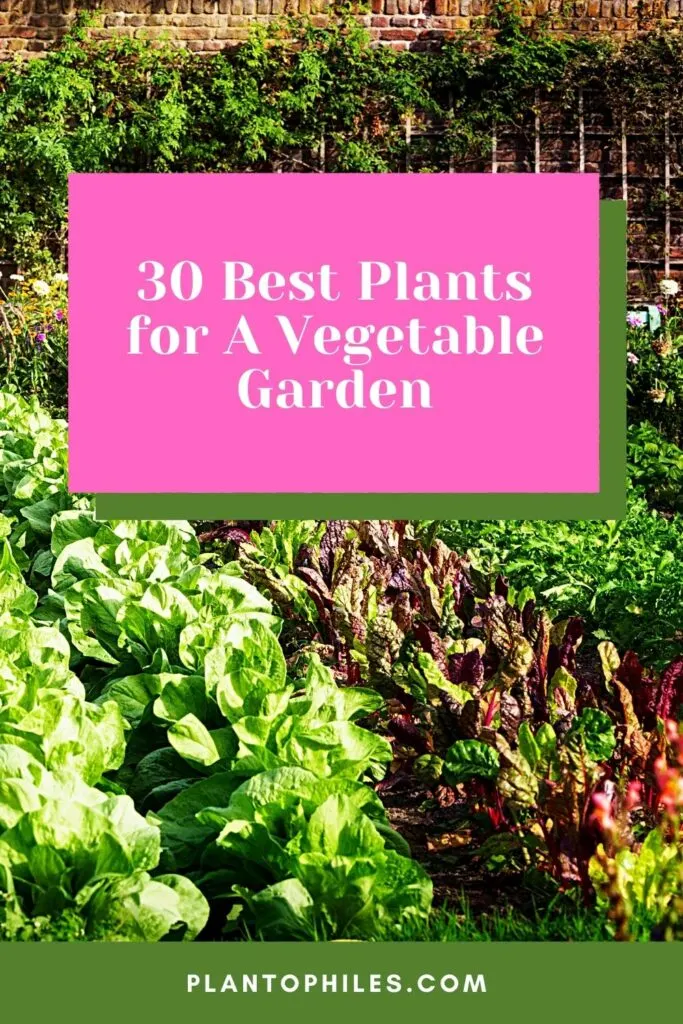
Table of Contents
Best Plants for A Vegetable Garden – 30 Best Choices
1. Arugula (Eruca vesicaria ssp. sativa)
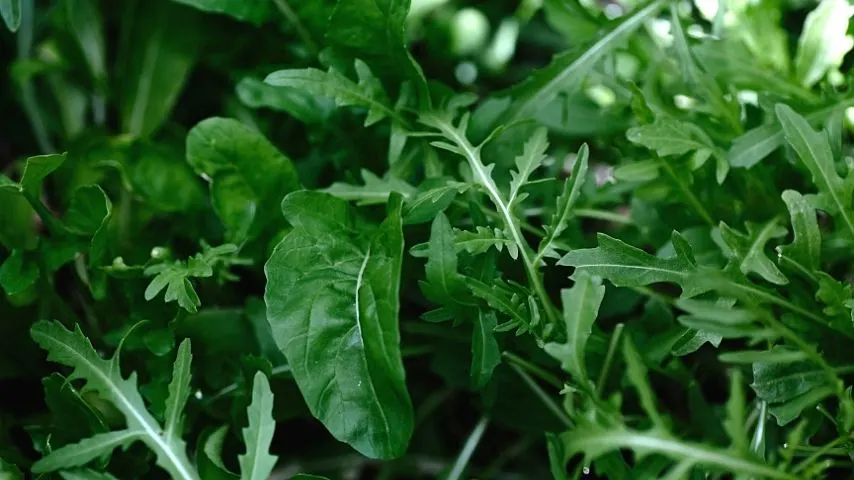
Arugula is a very healthy vegetable with a longish inflorescence, according to the University of Berkeley that gives a distinct taste and spice to your salad, pasta seasonings, and much more.
It is a cool-season green vegetable you can sow directly in spring or fall.
Once the leaves are about two to three inches long, cut them regularly to maintain their shape and prevent infections.
2. Asparagus (Asparagus officinalis)
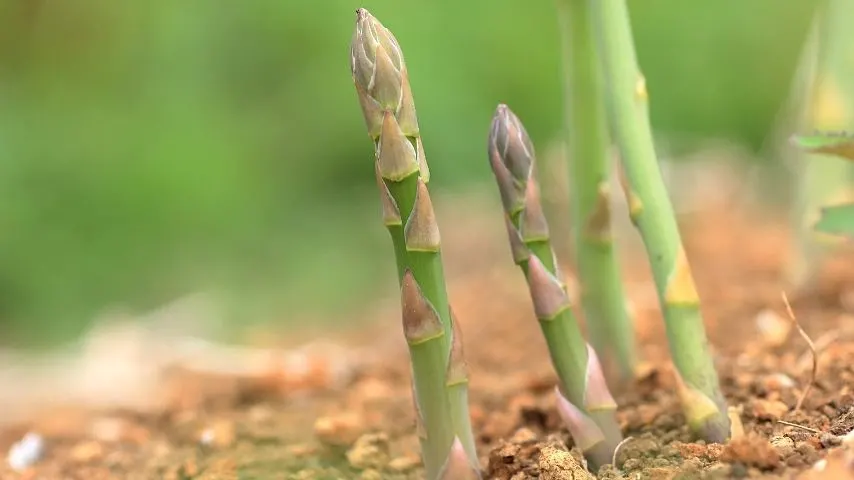
Asparagus, being a perennial vegetable, is very easy to plant. All you have to do is plant it once with the help of seeds or simply use a transplant, and then just wait for the magic to happen.
The first shoots will appear when the temperature reaches around 50 degrees Fahrenheit (10 degrees Celsius).
Make sure that you give this plant enough space to grow because, with time, it will begin to spread over the entire area, and you do not want to destroy the healthy plant.
This plant needs loamy soil, and the USDA growing zones are 3 to 10, which makes it a pretty convenient plant to have in your vegetable garden.
3. Lettuce (Lactuca sativa)

The best time to grow lettuce is the cool and wet season of spring. You can choose from various lettuce varieties to plant, based on where you live.
If you live in an icy region of the country, Romaine or Butterhead are some of the best options for you as they are incredibly cold-tolerant.
To plant lettuce, you should have the availability of rich and organic soil mixed with peat moss. The USDA growing zones for this plant are 2 to 11.
4. Peas (Pisum sativum)
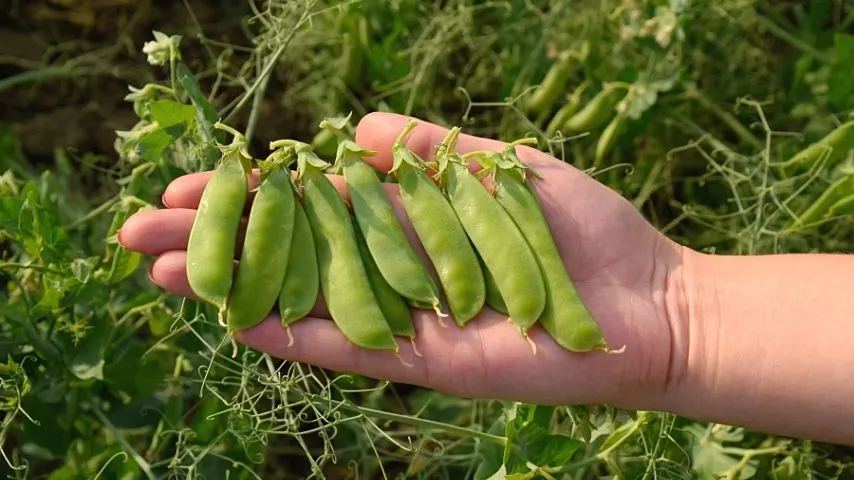
Peas are very common for being planted on St. Patricks Day. However, some people may not be able to plant it because, at that time, snow is probably covering the entirety of their gardens.
The best time to plant peas is the month of March and April. It has a wide range of temperatures where you can grow peas; the USDA growing zones are 2 to 11.
The soil that’s best for this plant is well-drained and rich in organic matter.
5. Rhubarb (Rheum rhabarbarum)
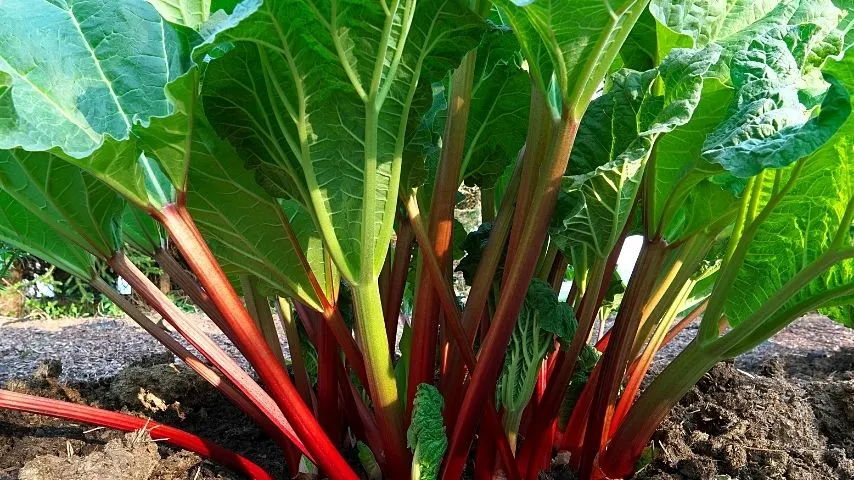
Rhubard is one of those plants that you have to plant once and then reap its benefits for years.
Once you make all your effort to establish the bed for its plantation, you can have freshly produced rhubarb at your ease for the next decade.
Rhubard needs rich, organic soil so that it can last for a long time. Its USDA growing zones are 3 to 8, and it can survive in full to partial shade.
6. Spinach (Spinacia oleracea)
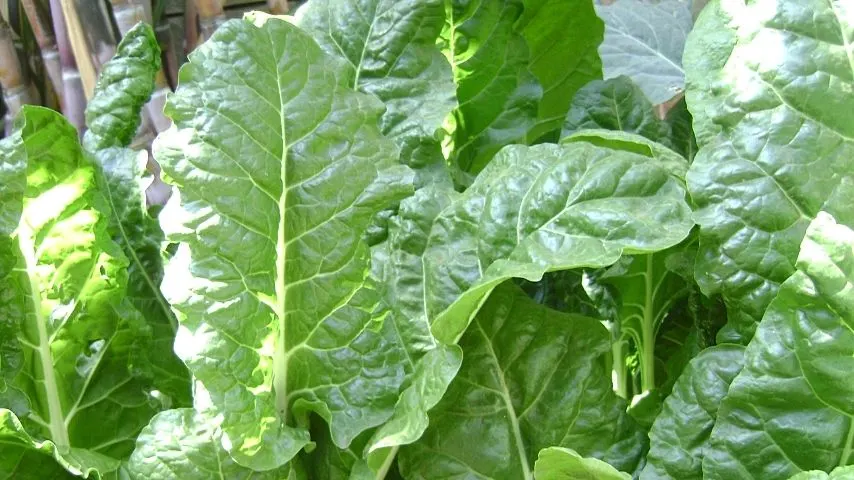
Spinach is known for its excellent use in salads, pasta, and smoothies. It has iron and magnesium in abundance, which adds to its nutritional value.
Once you plant it, you will not have to wait for months before it finally grows. It grows rapidly, and you don’t need to do much other than watering it occasionally.
The pH of your planting soil should be neutral, and the soil should be fertile so that the vegetable does not quickly bolt.
The USDA growing zones for this vegetable are 2 to 11.
7. Beets (Beta vulgaris)
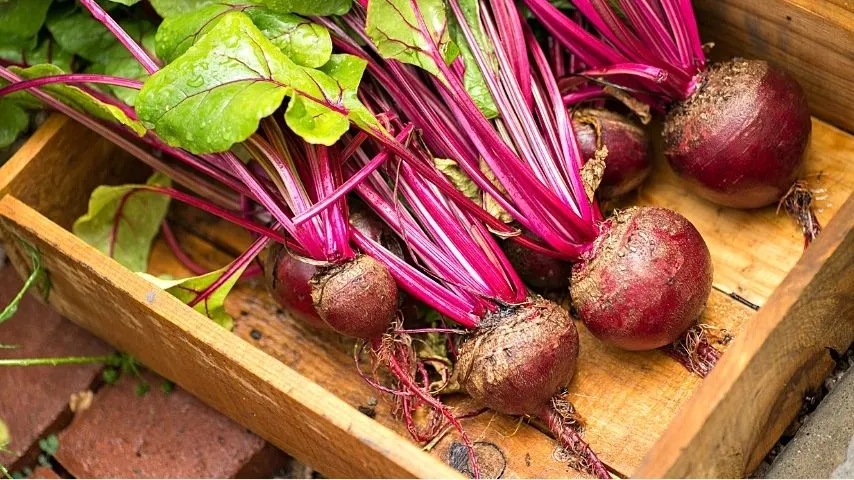
Beets are low-maintenance vegetables because they are not highly intolerant to snow and can survive repeated light frosts. Moreover, it takes about seven to ten weeks to mature after you have planted it.
To aid this plant to thrive, give them space. Beets love to have their own space to grow at their optimum rate.
Not cluttering these plants together will also ensure proper air circulation for them.
Soil should be loamy, light, and well-drained. The USDA growing zones are 2 to 11.
8. Zucchini (Cucurbita pepo)
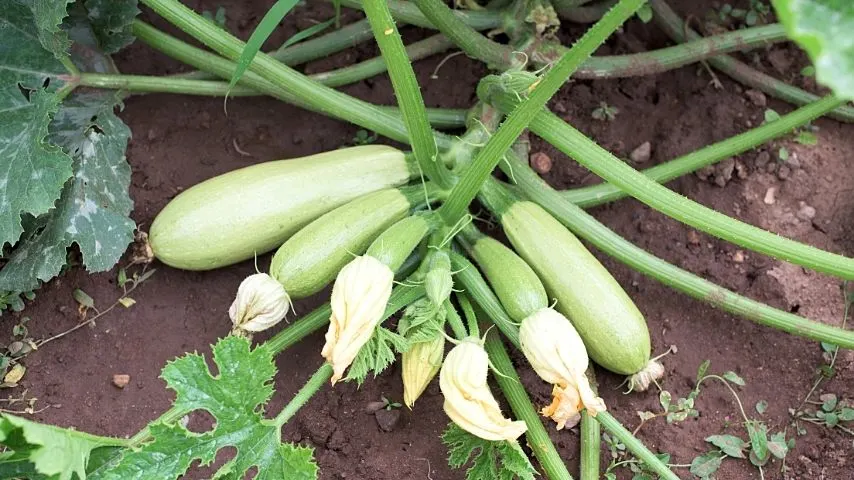
You can plant zucchini after the last frost has passed, after which they will germinate in about ten days.
Although zucchini is very easy to grow and maintain, it can be affected by a number of plant diseases and lead to wilting if proper care is not provided.
The most common disease for zucchini is powdery mildew, but it can be treated in a few days if caught in the earlier stages.
9. Radish (Raphanus sativus)
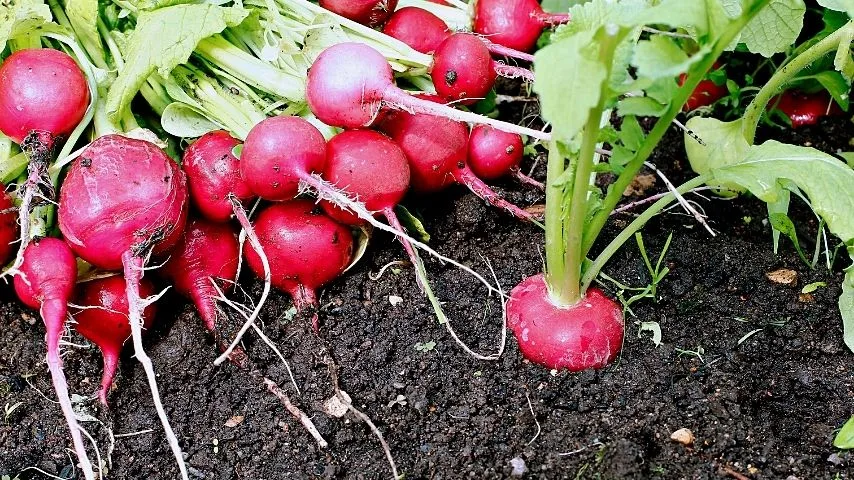
Radish greens are edible and provide a slight peppery flavor to salads and sandwiches. Ensure that you give them proper moisture; otherwise, the plant tends to become very hard and fibrous.
You can plant radishes in a container or a garden, according to your availability.
10. Kale (Brassica oleracea var. sabellica)
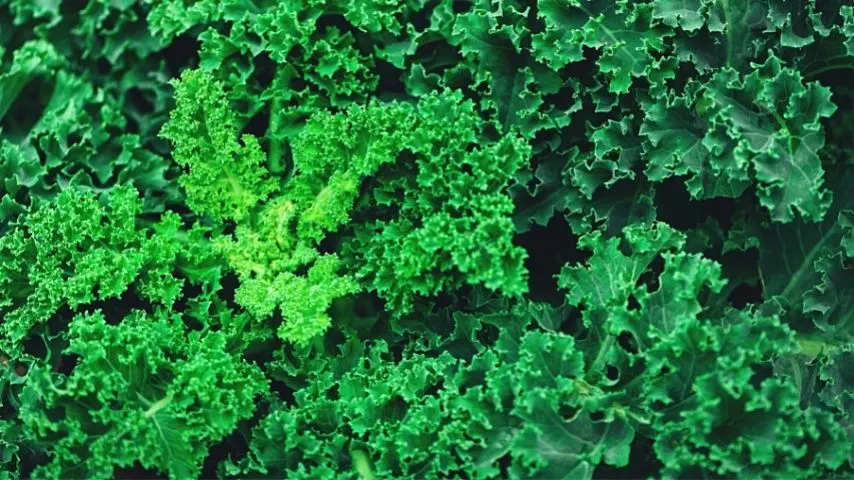
Growing Kale is very easy in the cold season. After establishing the bed for the growth of Kale, you can rely on it to grow itself naturally.
Once in a while, water it and look for signs of white patches or discoloration of leaves.
While the small and young leaves of Kale taste incredible when eaten raw in salads, you can also cook the mature leaves just like spinach to soften the leaves a bit.
11. Swiss Chard (Beta vulgaris subsp. vulgaris)
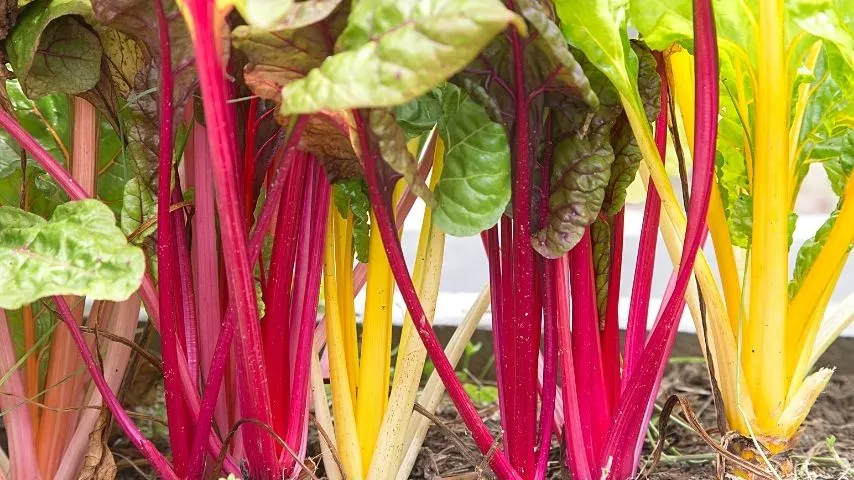
There are a lot of varieties you can choose from when it comes to planting swiss chard in your vegetable garden.
Bright light is one such variety you’d be more than happy to grow in your garden.
You can cook swiss chard like spinach or eat it raw in salads. As for the stalk, swiss chard is commonly used as a substitute for celery stalk as it has the same flavor and appearance with the latter.
To have swiss chard in your garden all year long, you should fertilize it with fish emulsion once in two or three weeks.
12. Beans (Phaseolus vulgaris)
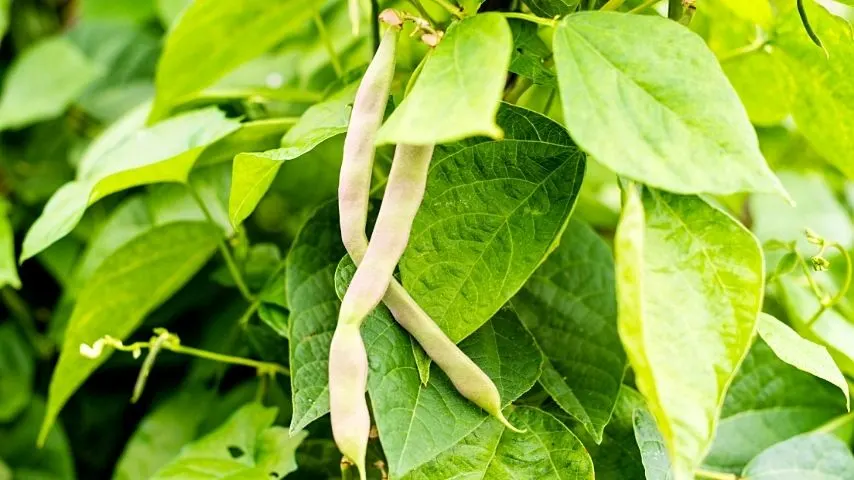
The common options you have while planting beans are either pole or bush beans. The right time to plant bean seeds is after the soil has warmed a little after the frost season.
While pole beans should be grown at least six inches apart, bush beans will do with three to four inches of distancing.
You may need a trellis to prevent the beans from spreading here and there erratically.
Harvest them when the beans are still considerably thin and have not become too thick.
13. Cucumber (Cucumis sativus)
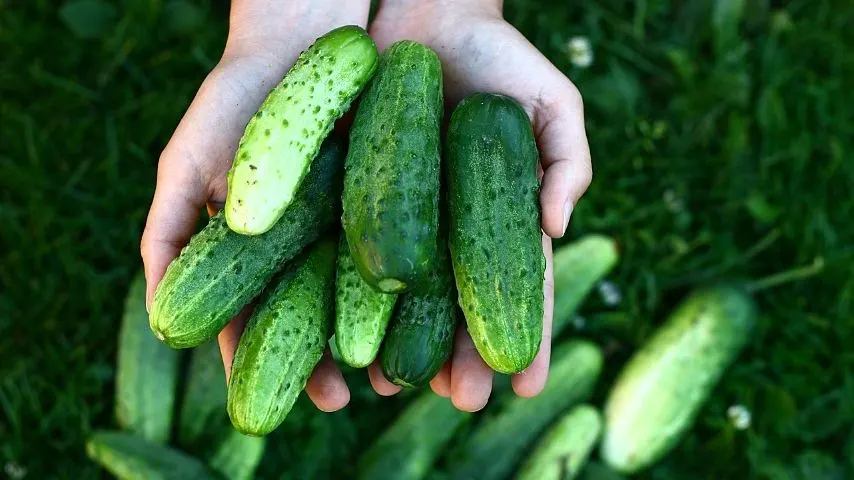
With cucumbers, you also have a lot of options. You can go ahead with vining types, for which you will eventually need a trellis to support the vines.
Moreover, you can choose bush, slicers, or pickling cucumbers. For a well-developed fruit, make sure to keep the plant moist and not let it dry out.
If the plant dries out in the critical period of harvesting, you will eventually end up with a hard and bitter fruit.
14. Carrots (Daucus Carota)
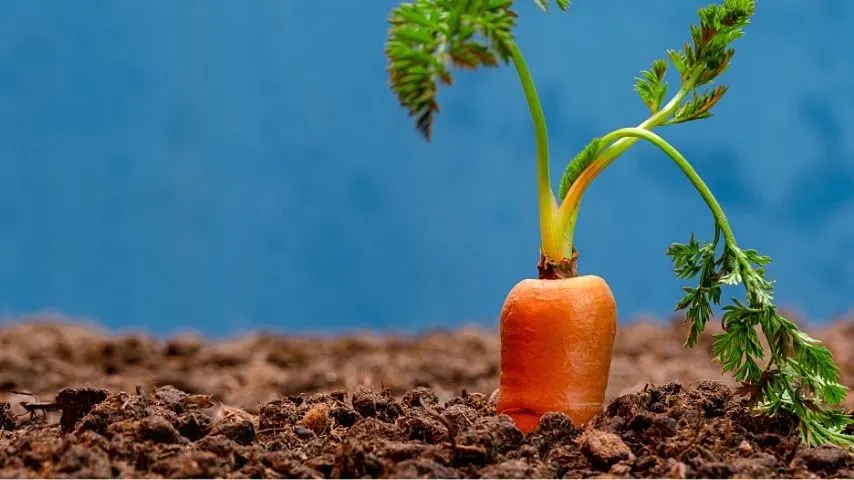
Carrot is quite a tricky and challenging vegetable to grow in your garden. The expensive long and thin carrots you see in the supermarket are particularly tough to plant because they take months to mature.
While they are developing at their own pace, the insects embedded in the soil will start eating your lovely carrots from the bottom.
For this reason, it is recommended to start growing relatively more straightforward species of carrots such as Paris Market or Little Finger. They have a crunchy texture and mature way faster than the latter.
Carrots usually need well-drained and loose soil to spread roots under the plant quickly. The USDA growing zone for carrots is 2 to 11.
15. Horseradish (Armoracia rusticana)
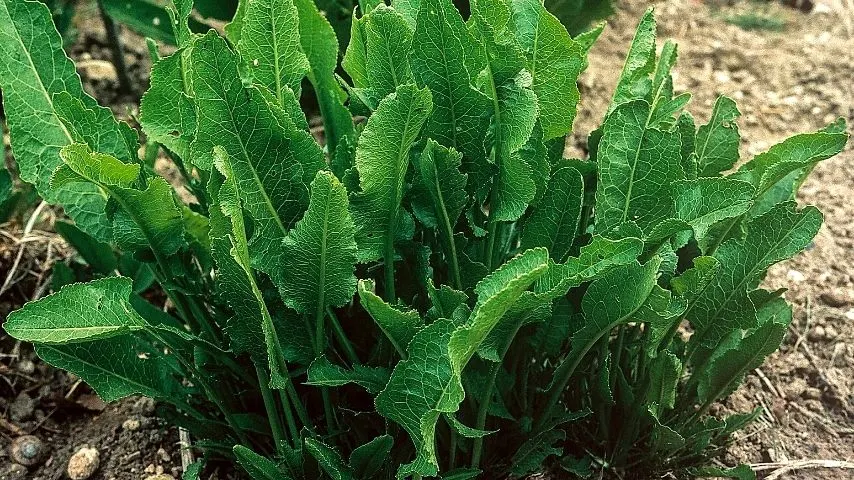
It is better to grow horseradish in a planting pot and treat it as an annual plant because if you do it otherwise, there is a strong likelihood that you will not be able to get rid of this plant at your whim.
Even if you leave a little root inside the soil, you will soon find the ground spreading with another unexpected horseradish harvest.
16. Onions and Shallots (allium cepa)
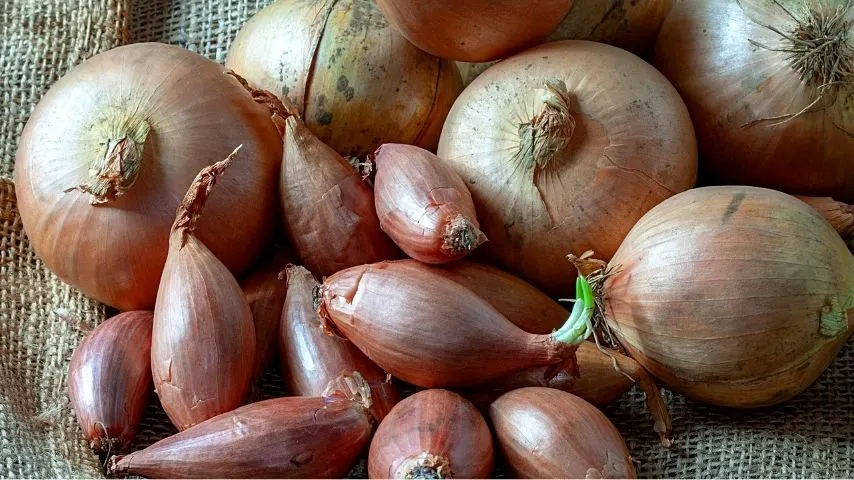
To grow onions, you must walk the extra mile to have fruitful results. To plant onions, you have three options.
Firstly, you can use a transplant and put it in your garden; this is the easiest method so far. Secondly, you can do it with seeds, which will be tricky.
Thirdly, you can use tiny onion bulbs and place them in rich organic soil for further growth in your garden.
While onions are very adaptable to changes in temperature, the best USDA zone for their growth are 5 and 6.
The pH of the soil is acidic, and the nature of the ground should be loamy or heavy clay.
17. Parsnips (Pastinaca sativa)
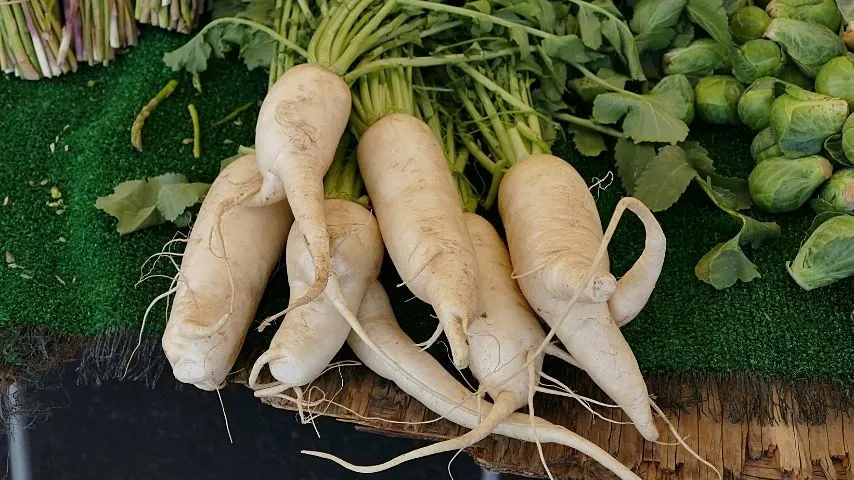
The best part about growing parsnips is that you can grow them in any USDA zone.
While they are often confused with carrots or radishes, they have a distinct flavor, making them worth the plantation and the wait.
You can eat parsnips in various ways, according to your liking. You can either clean them and have them raw, boil them, sprinkle some sea salt, mash them, or sautee them to light brown.
An ideal soil for parsnips is loose and acidic soil rich in organic matter.
18. Potatoes (Solanum tuberosum)
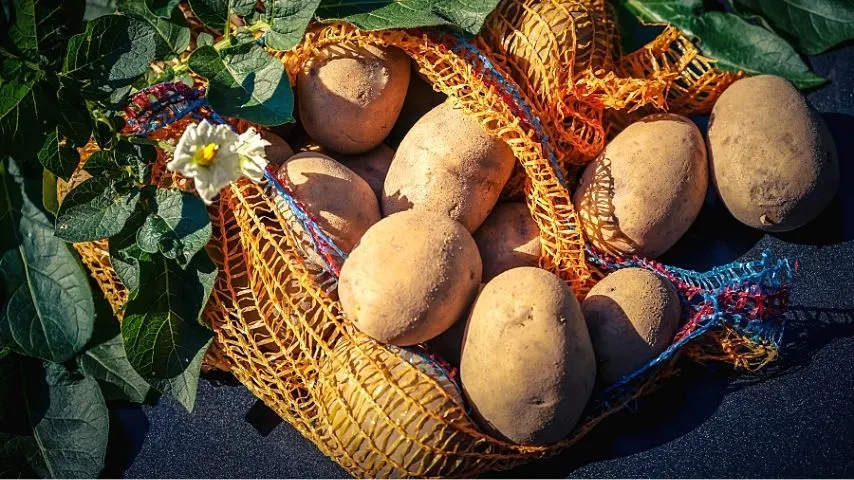
While potato is a stem tuber and not a root crop, it is grown like one. They’re an everyday staple you can have in your diet in various ways.
The simplest is to roast them and sprinkle some seasoning, but you can also use other methods such as boiling, frying, or steaming.
The USDA growing zones for Solanum tuberosum are 2 to 11, and they thrive in full sunlight, ranging from about six to ten hours of daylight daily.
19. Radishes (Raphanus sativus)
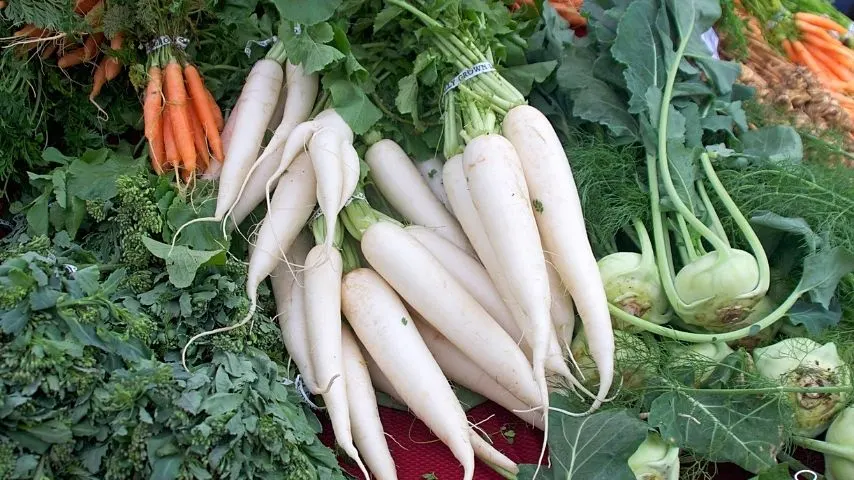
The best time to plant radishes is when your soil is warming up a little bit after the frost season has passed.
Since radishes are very much vulnerable to bolting and in cooler temperatures, plant your radishes as soon as your soil is set.
There is a variety of radishes that you can consider planting, which include spicy radishes, winter radishes, or silver-thin radishes.
20. Rutabaga (Brassica napus)
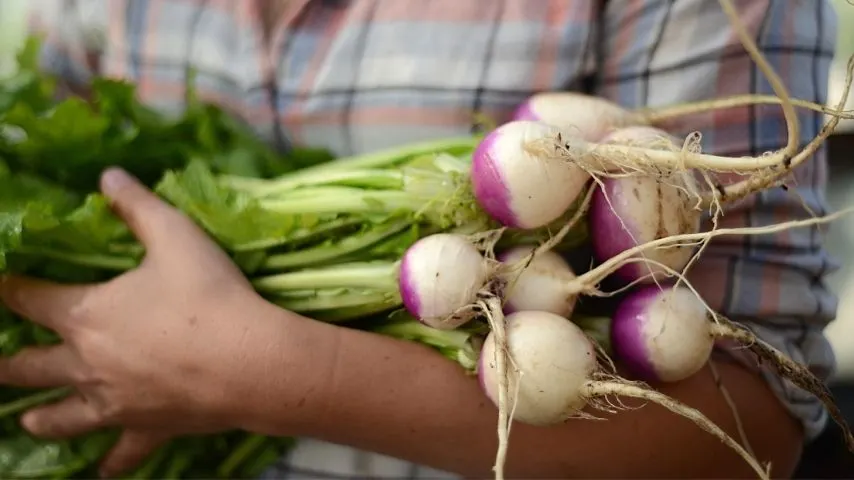
Rutabagas are easy to grow in a vegetable garden as they do not need much space, water, or fertilizer.
This vegetable has a crispy texture; however, it is reduced to half its weight and becomes incredibly buttery when cooked.
They are ideal to be used for pie because of the buttery luscious texture that they give when cooked.
These plants need a maturation period of about 90 days or even more, so make sure you give it that time before it is ready to be harvested.
It requires well-draining and slightly acidic soil that is free of excess water. Otherwise, this will rot the roots and eventually inhibit the growth of rutabagas.
21. Sweet Potatoes (Ipomoea batatas)
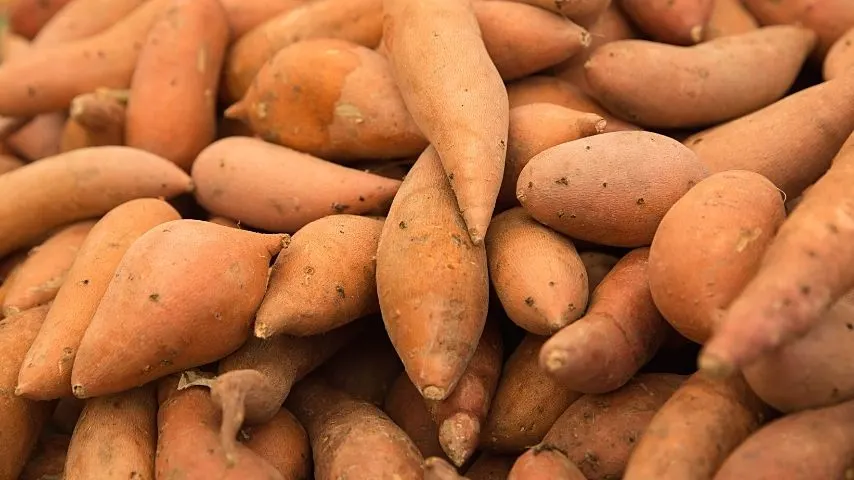
The best thing you can do to grow sweet potatoes is to plant them in a container box and keep them indoors until the soil begins to warm.
Because they need a growing period of at least four months and do not do well in colder temperatures, the right thing to do is keep them indoors until they are adaptable to the temperature outside.
Sweet potatoes are grown with small rooted pieces of tubers that grow ideally in the USDA growing zones of 8 to 11.
It survives in full to partial shade and needs well-drained and rich soil.
22. Turnips (Brassica rapa)

Turnips come in different forms and sizes; there are white turnips with purple tops and golden and bright red. Also, you can eat both the roots as well as the greens.
While the greens do well in salads and pasta, you can use the root tuber for numerous fillings in pies and cakes.
They are very easy to grow because they can grow in any USDA zone and do not take much time to mature.
23. Bok Choy (Brassica rapa subsp. chinensis)

Bok Choy grows quickly, reaching about eight to nine inches long in only forty days. They are heat tolerant, so you don’t have to worry about the temperature conditions when growing this vegetable.
However, do look out for insects as the root of this plant is vulnerable to attacks by many bugs that will eventually rot the entire plant.
24. Brocolli (Brassica Oleracea)
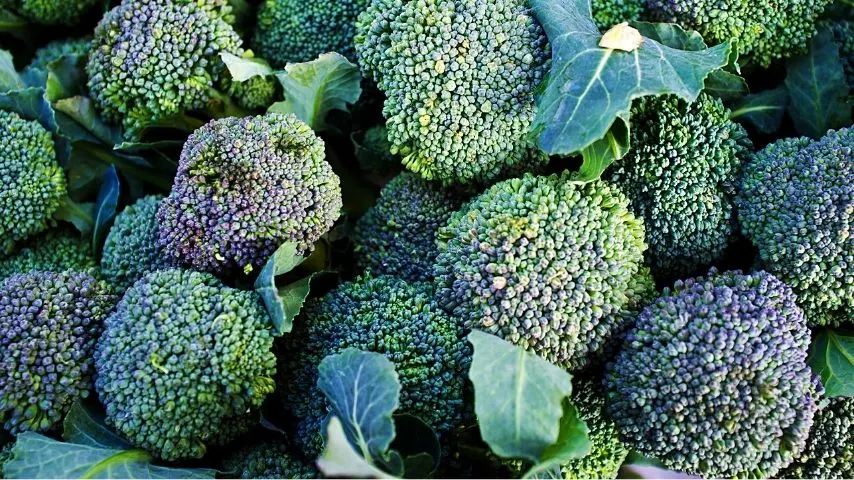
Brocolli is an excellent vegetable for roasting, salads, and more. You can easily plant them in your vegetable garden about four to five months before fall so that it has enough time for maturation.
Brocolli is vulnerable to getting attacked by pests. Therefore, it is the best practice to spray them lighting with a mild pesticide that protects it from pests and does not destroy the healthy florets.
The ideal USDA growing zones for broccoli are 3 to 10, and they can survive in full sun to partial shade.
However, if kept in complete shade for a long time, the growth of the vegetable may become stunted.
25. Cabbage (Brassica Oleracea)
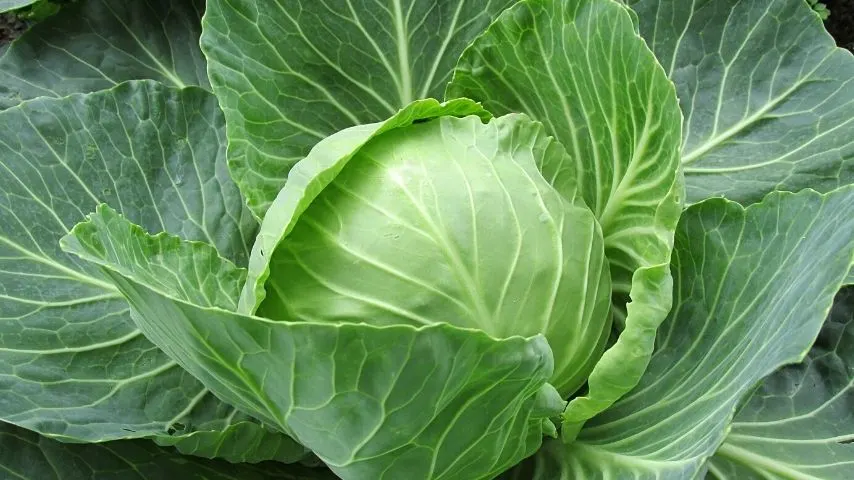
The proper season for planting this green vegetable is the season of summer.
Needing around three to four months to mature and produce a large head, you should plant your seeds around mid-summer to have the cabbage ready by fall.
You should have well-drained and rich soil to grow cabbage mixed with peat moss or other organic components.
It thrives in full sun to partial shade, and the ideal USDA growing zone for Brassica oleracea is 1 to 9.
26. Cauliflower (Brassica oleracea)
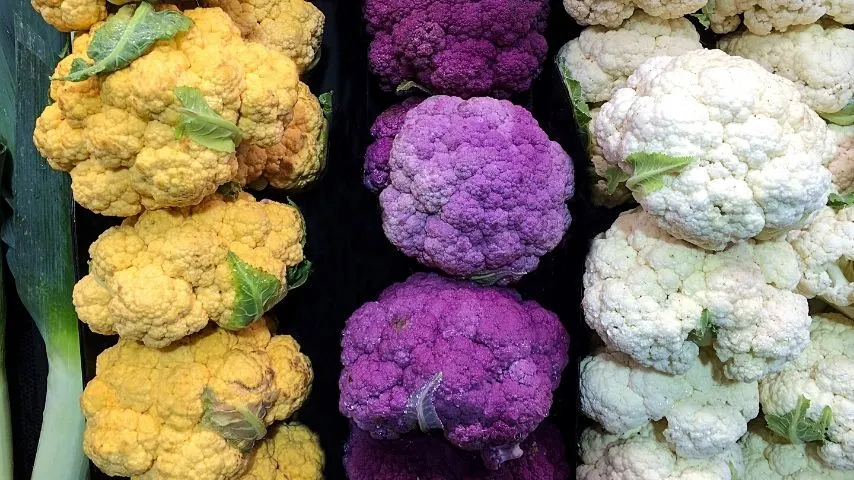
While growing cauliflower, remember that it is an extremely slow grower and takes a lot of time for maturation.
Therefore, if you want to harvest your cauliflower in mid-fall, you should plant it about four to five months earlier.
Pluck the heads from the plant when they have reached a desirable size, and their buds are still tight.
The optimum growing zones for cauliflower are 2 to 11, and it thrives in full sun.
27. Cilantro (Coriandrum sativum)
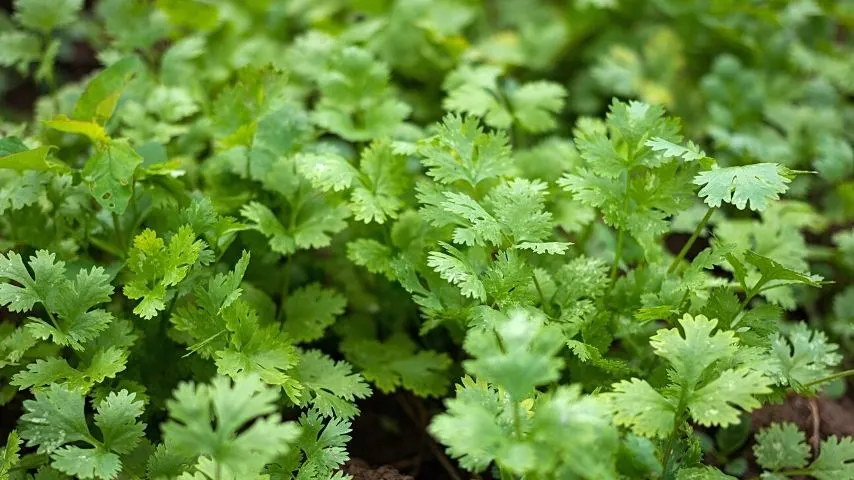
To grow cilantro, you should have slightly acidic soil that is well-drained and moist. Moreover, ensure you provide cilantro with full to partial sun and give it about two to three months to mature.
In many cases, it grows up to one to two feet tall.
28. Collards (Brassica oleracea var. viridis)
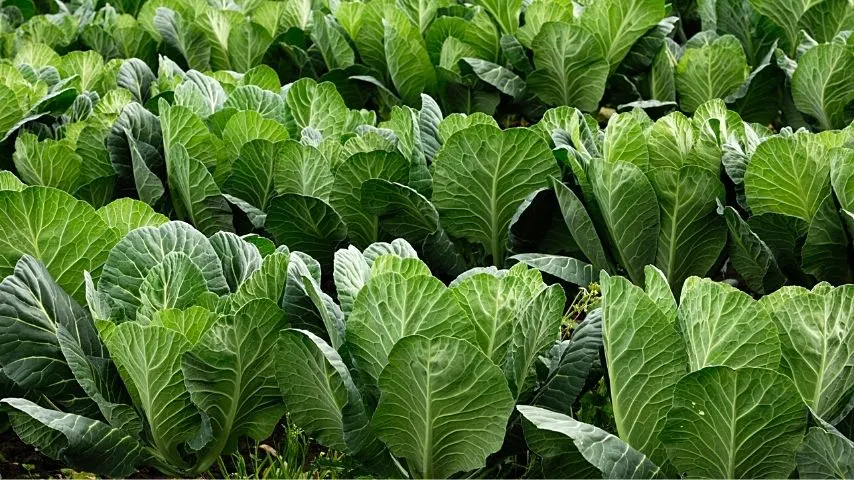
The ideal growing zones for collards are 2 to 11, requiring about eight to ninety days to mature before being ready to harvest.
Collards need well-drained yet moist soil that is rich in organic material.
29. Corn Salad (Valerianella locusta)
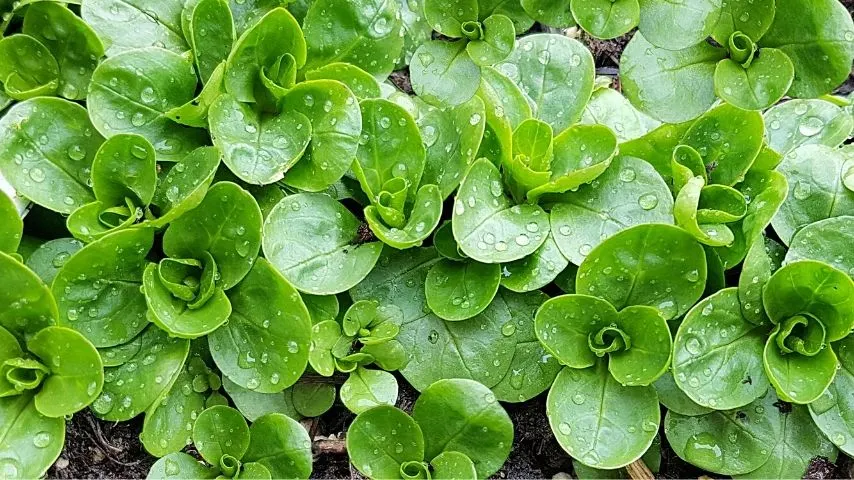
In some regions, corn salad, or locusta, grows in full to partial sunlight and requires around forty to seventy days to mature.
The correct pH of the soil for optimum growth should be slightly acidic. Moreover, the soil should be loamy and drained of excess water.
30. Dill (Anethum graveolens)
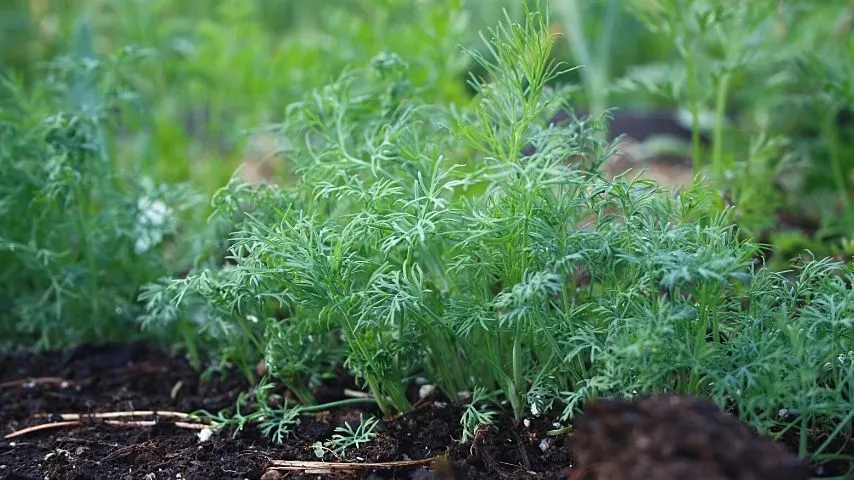
Dill is one of those plants growing by themselves in a garden, with little to no attention.
All you need to do to encourage the growth of dill in your garden is to keep the soil moist at all times so that it has all the nutrition it requires for its silent yet enormous growth.
The USDA growing zones for dill are 2 to 11, and it thrives in full sun. It grows up to three to five feet tall and usually requires about three months to mature.
Closing remarks
With the list of the best plants for a vegetable garden you are prepared for a great growing season and harvest.

Daniel has been a plant enthusiast for over 20 years. He owns hundreds of houseplants and prepares for the chili growing seasons yearly with great anticipation. His favorite plants are plant species in the Araceae family, such as Monstera, Philodendron, and Anthurium. He also loves gardening and is growing hot peppers, tomatoes, and many more vegetables.


